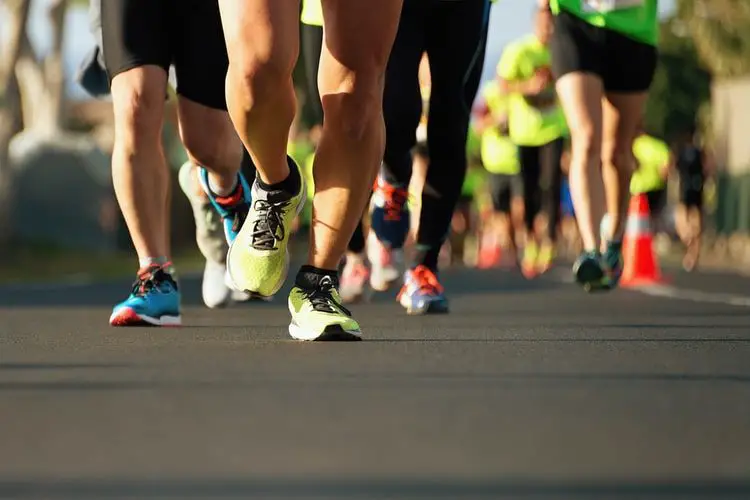Running is the exercise of choice for a lot of people, and for good reason. It’s easy to do just about anywhere, free, gets the heart rate up and motivates you to spend time outdoors. While running is a great sport to get into, it can take a toll on the body if certain precautions aren’t taken.
In this article, you’ll learn why simple movements like walking and running are so important to counter the risks of staying sedentary, and how to easily and safely start running.
Dangers of a Sedentary Lifestyle
A sedentary lifestyle isn’t just about weight management and loose skin. The more time you spend sitting and not moving, the shorter your lifespan will probably be.
Research shows that by sitting for long periods of time, the lack of muscle contractions experienced can decrease blood flow throughout the entire body, and reduce the efficiency of various biological processes. Believe it or not, only one hour of sitting can lessen the blood flow to the main leg artery by 50%. By getting up every hour to take a short walk and focusing on key dietary strategies like weaning off sugar, you’re on your way to dramatically decreasing your risk of heart disease.
The good news is, it doesn’t have to be as complicated as hiring a personal trainer or buying a gym membership. Simply learning how to get started with a simple running program outdoors provides major health benefits, and can be done anywhere.
Why Walking and Running are Natural for the Body
Both walking and running are ways that the human body was designed to move and function. Sitting, on the other hand, flexes the body forward which inhibits posture and proper breathing techniques. Over time, oxygenation of the blood and organs diminishes, and even eating the healthiest of diets becomes undermined, as you’re not able to effectively digest food and assimilate nutrients.
Even if your body isn’t able to run or isn’t ready quite yet, walking is an excellent alternative and perfect way to get started, instead of jumping right into a running routine. Good digestive function begins with good posture, and walking is a highly effective way to achieve both. Walking also stimulates the sympathetic nervous system, which is the body’s “rest and digest” mode.
9 Ways to Start Running
Regardless of your fitness level, consider these nine ways to safely and effectively start running.
Dynamic Stretch Before Running
A lot of injuries can be prevented by simply knowing how to stretch. Contrary to popular belief, dynamic stretching is the best type of stretching to do before gearing up for a run. This type of stretching refers to movement-based stretching that primes the muscles and joints for load and movement. The types of dynamic stretches you’ll do depend on which type of exercise you’ll be doing. In the case of running, excellent dynamic stretches might include butt kicks, leg swings and hip circles.
Static Stretch After Running
Static stretching, on the other hand, is the type of stretching you will do after exercise. These involve holding each stretch for at least 30 seconds, and the point is to relax the muscle that is being stretched and increase flexibility. After a run, great stretches can include lying hamstring stretch, quad and glute stretches, adductor (inner thigh) and groin stretches, hip flexor and hip stretches.
Do Squats
While it might seem odd that resistance training is so important, it’s actually a common mistake that many runners make that leads to imbalance and potential injury. Developing and/or maintaining a strength training routine is critical injury prevention.
Many fitness experts see the squat as one of the most important functional movements to include in your routine as a runner. The squat is a total body movement that especially provides lower body strengthening and mobility. Squat form is harder than it looks, as you need a certain level of flexibility and mobility to execute proper form. Definitely wait to add any load (dumbbells, barbell, etc) until your squat form is perfected.
Squats are especially important for runners as they target knee stability, which is key for avoiding injury.
Don’t Forget Deadlifts
Deadlifts are another compound exercise (they work multiple muscle groups and joints) and particularly focus on posterior chain (glutes, hamstrings, back, etc), all of which are important for runners. This beneficial exercise can even help you improve your posture!
This lift is excellent for power, endurance and speed, but it’s critical to get some coaching on form if you’re unsure. Once you have it mastered, you can slowly begin increasing your load (weight). If you don’t belong to a gym, consider buying an at-home weight and barbell set for deadlifts and other weight-bearing exercises.
Focus on the Core
A solid core is fundamental for avoiding injury as a runner, as it allows you to have proper form, balance and control.
Planks are a fantastic exercise that target all core musculature. You can do regular, forearm or hand planks, or modify them with side planks, spiker planks and supine planks.
Core work and other strength-based exercises might seem impossible if you spend long hours at a desk, but check out these exercises and ways to burn calories while seated for some ideas.
Allow Your Body to Recover
This goes for all types of exercise, and definitely holds true for runners. To start running, you need to allow for proper recovery time, and if you are injured, stop. Not forever, but long enough to allow your body to heal. Recovery time depends on your body, running routine and fitness level, and tuning into the body’s cues is important. If you’re just starting out and feel very sore after a run, give yourself 1-2 days off. On those days, you can do other types of gentle movement like swimming or walking.
For an excellent read that debunks the myths and discusses the science of recovery, check out Good to Go by Christie Aschwanden.
Increase Challenge Gradually
Increase the length of your runs and your speed gradually is another factor to consider as you start running. If you throw your body into an eight mile run when it has really only been running three or four, this is a sure way to become injured. Along those same lines, increase one variable at a time. For example, if you usually run on flat ground, you could continue with the same distance but include hills or stairs. Or, stick with flat ground but increase distance, instead of increasing both variables at once.
Invest in Good Running Shoes
Investing in a high quality pair of running shoes is well worth it. If possible, check out a local sporting goods store or one that specializes in running, where you can have a professional measure your feet, analyze your stride, and fit you with a good pair.
Several of my clients have loved Adidas Ultra Boost running shoes, and really felt like they improved their running.
Develop Proper Form
Along with the above-mentioned ways to safely start running, also consider the following pointers for proper running form:
-
Take short strides
Don’t lengthen your stride too much, as this can lead to injury. Instead, take short, quick strides.
-
Be aware of foot positioning
Similarly to proper squat or lunge form, be aware that your foot doesn’t land in front of you knee on any given stride. Instead, the foot should land just beneath the knee.
-
Stay stream-lined with the arms
In other words, don’t flail your arms and elbows. Keep the arms relaxed at a 90 degree angle by your side, with hands below your chest. This is important to keep a strong center of balance, not to mention increase efficiency and speed.
-
Use the ground behind you
Instead of reaching forward with your front foot, focus on pushing off the ground with your back foot.
-
Look ahead when climbing a hill
When going uphill, be mindful to keep your head and chest up, and to look ahead instead of down at your feet. Push off the ground with your back food and stay more on your toes.
-
Be careful on the downhill
Going downhill presents its own specific challenges, and can leave you vulnerable to injury. Keep your upper body and head upright and look forward. Maintain short and soft strides and your head over your toes, instead of hinging forward at the hip.
Just like any new exercise, begin running slowly if you’re a beginner. Once you develop the habit of moving your body, breathing fresh air and working up a sweat, you’ll probably find that the benefits to your body, mind and spirit will motivate you to keep it up.









